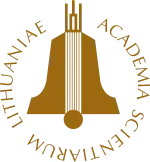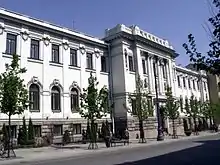| Lietuvos mokslų akademija | |
 | |
 Lithuanian Academy of Sciences, built in 1903–1906, architect Mikhail Prozorov | |
| Formation | 16 January 1941 |
|---|---|
| Type | Academy of sciences |
| Headquarters | Gedimino pr. 3, Vilnius, Lithuania |
| Coordinates | 54°41′11″N 25°17′5″E / 54.68639°N 25.28472°E |
President | Jūras Banys |
| Website | lma.lt |
The Lithuanian Academy of Sciences or LMA (Lithuanian: Lietuvos mokslų akademija, Latin: Academia Scientiarum Lithuaniae) is a state-funded independent organization in Lithuania dedicated for science and research. Its mission is to mobilize prominent scientists and initiate activities that would strengthen the welfare of Lithuania and contribute to the scientific, social, cultural and economic development of the country.[1]
History
The idea of establishing the Lithuanian Academy of Sciences was proposed in 1773 by Martynas Počobutas and other members of Vilnius University in the Grand Duchy of Lithuania, but it was not implemented due to wars and conflicts in the region.[2][3] The idea of an independent institution for science and research was revived during the Lithuanian National Revival with the main proponents of it being the members of the Lithuanian Scientific Society, including Jonas Basanavičius and Jonas Šliūpas.[4] However, the implementation began only in 1939, initially with the establishment of the Institute of the Lithuanian Language.[3][4] The institute was a basis of the Lithuanian Academy of Sciences which was formally established on 16 January 1941.[2] Its first president was Vincas Krėvė-Mickevičius.
On 9 June 1988, the Sąjūdis movement was started from the Academy’s conference hall. In 1989, the Lithuanian Academy of Sciences was declared independent from the Academy of Sciences of the Soviet Union, and in March 1990, the Academy declared its decision to be independent of any public or political institution. In 1991, the Law on Research and Higher Education was adopted and LMA was reorganized. On 18 March 2003, the Seimas passed the Statute of the Academy of Sciences.[2]
Activities
The LMA is governed by its charter which is approved by the Parliament of Lithuania. It can elect 120 members (under 75 years of age) and an unlimited number of foreign members as well as emeriti over 75 years of old.[1]
The academy represents Lithuania in All European Academies, International Council for Science, European Academies' Science Advisory Council and InterAcademy Partnership. In addition to founding several scientific institutions and foundations, it issues publications and textbooks, sponsors symposia and conferences. It has established 15 memorial prizes and awards, encourages young scientists and students to engage in research by annually awarding 10 prizes to young scientists and 15 prizes to students. Since 2008, together with the Bank of Lithuania, it grants Vladas Jurgutis Award.
Structure
LMA consists of the following scientific divisions:[5]
- Humanities and Social Sciences
- Mathematical, Chemical and Physical Sciences
- Biological, Medical and Geosciences
- Agricultural and Forestry Sciences
- Technical Sciences
Publications
- Acta Medica Lituanica
- Baltica : an international yearbook of Baltic Sea geology, geomorphology and paleontology
- Biologija
- Chemija
- Ekologija
- Energetika
- Filosofija. Sociologija
- Geografija
- Geologija
- Lituanistika
- Pheromones
- Menotyra
- Žemės ūkio mokslai
References
- 1 2 "The Lithuanian Academy of Sciences -- About". Lithuanian Academy of Sciences. Retrieved 15 September 2021.
- 1 2 3 "History of the Lithuanian Academy of Sciences". Lithuanian Academy of Sciences. Retrieved 6 September 2023.
- 1 2 "Lietuvos mokslų akademija" (in Lithuanian). Visuotinė lietuvių enciklopedija. Retrieved 15 September 2021.
- 1 2 "Dėl Lietuvos mokslų akademijos statuto patvirtinimo" (in Lithuanian). 19 May 2011. Retrieved 15 September 2021.
- ↑ "Structure". Lithuanian Academy of Sciences. Retrieved 15 September 2021.
